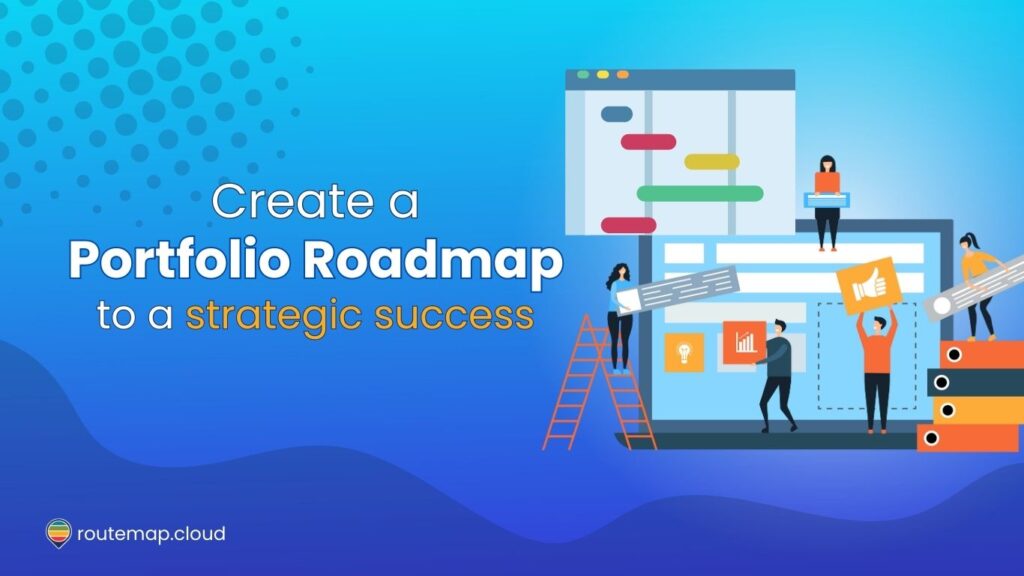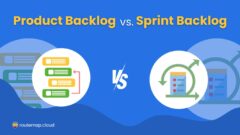In today’s dynamic business landscape, organizations face the challenge of managing multiple projects, products, or initiatives concurrently. Therefore, using a portfolio roadmap is extremely important to ensure alignment with strategic goals.
Moreover, it serves as a valuable tool for organizations to strategically plan and coordinate their various efforts within a portfolio.
In this article, we will go through the significance of portfolio roadmaps, compare them with strategic roadmaps, and learn how to a powerful one for strategic success.
What is a portfolio roadmap?
A portfolio roadmap is a strategic document or plan that outlines the vision, goals, and direction for a portfolio of projects, products, or initiatives within an organization. It also provides a high-level overview of the portfolio’s objectives, priorities, and timelines.
As a result, stakeholders can understand how different components of the portfolio align with the organization’s overall strategy.
The primary purpose of portfolio roadmaps is to guide decision-making and resource allocation by providing a clear picture of the portfolio’s trajectory. Additionally, it helps stakeholders, such as senior executives, project managers, and product owners, make informed choices about which initiatives to invest in.
Especially when initiating or retiring projects, portfolio roadmaps also show stakeholders how to balance resources across different efforts.
Portfolio roadmap vs Strategic roadmap: what’s the difference?
A portfolio roadmap and a strategic roadmap are similar in that they both provide high-level plans and guidance for an organization. However, they differ in their scope and focus.
1. About portfolio roadmaps
A portfolio roadmap, as discussed earlier, provides an overview of a collection of projects, products, or initiatives within an organization. It aligns these efforts with the organization’s strategic objectives, priorities, and resource allocation.
Moreover, the portfolio roadmap helps stakeholders understand how different components of the portfolio fit together and progress over time. More importantly, it guides decision-making and ensures that the portfolio is managed effectively.
2. About strategic roadmaps
On the other hand, a strategic roadmap is a high-level plan that outlines an organization’s overall strategic direction. It goes beyond the portfolio level and encompasses the entire organization or business unit.
Besides, the strategic roadmap helps articulate the long-term vision, goals, and initiatives that the organization aims to achieve. Additionally, it serves as a guide for making strategic decisions, setting priorities, and allocating resources across different portfolios or business areas.
How to create a powerful portfolio roadmap
With all of the given information, you can now move on to creating a portfolio roadmap for your organization. Although it may seem similar to creating other roadmaps, there will always be differences as we mentioned earlier.
Here are the steps to follow.
Step 1: Define your strategic objectives
You can start by clearly defining your organization’s strategic objectives. What are your long-term goals? What outcomes do you want to achieve?
Understanding your strategic direction is vital to ensure that your portfolio roadmap aligns with and supports your overall vision.
Step 2: Identify initiatives
It is crucial to identify and list all the projects, products, or initiatives within your portfolio. Therefore, you should consider both ongoing and future initiatives.
Remember, each initiative should have a clear purpose, desired outcomes, and a solid business case.
Step 3: Assess alignment
Evaluate each initiative’s alignment with your strategic objectives. Ask yourself: How does each initiative contribute to the overall goals? Are there any initiatives that do not align or may require adjustments?
A small tip is to prioritize the initiatives based on their strategic importance in the project.
Step 4: Determine timelines and dependencies
Now, you can move on to the next step and establish timelines for each initiative. Consider dependencies between different initiatives and identify any critical path dependencies that may impact the overall timeline.
By visualizing these timelines and dependencies, you can gain a better understanding of the sequencing and coordination required.
Step 5: Allocate resources
The next step is to evaluate the resources needed for each initiative, including budget, personnel, and technology. Besides, you should also determine if you have the necessary resources or if adjustments are required.
Efficient resource allocation is crucial for successful implementation.
Step 6: Mitigate risks
It is always important to identify potential risks and challenges associated with each initiative. You can start by evaluating the likelihood and impact of these risks and developing mitigation strategies to address them.
By proactively managing risks, you can minimize disruptions and maximize the chances of success.
Step 7: Create the roadmap
With the foundational work completed, it’s time to create your portfolio roadmap. You should use a visual format such as a timeline or Gantt chart to depict the initiatives, timelines, and dependencies.
Moreover, it is recommended to include key milestones and deliverables for each initiative. This will ensure that the roadmap is easy to understand and effectively communicates the strategic direction of your portfolio.
Step 8: Review and update
Remember that a portfolio roadmap is a dynamic tool that needs regular review and updates. As your organization evolves, new initiatives may arise, priorities may shift, or risks may change.
Besides, conducting periodic reviews will help you ensure that your roadmap remains aligned with your strategic objectives and reflects the latest developments.
Conclusion
Creating a portfolio roadmap is an essential step toward strategic success. By defining your objectives, aligning initiatives, allocating resources, mitigating risks, and creating a clear roadmap, you can effectively manage your portfolio and drive progress toward your strategic goals.
Besides, you should also regularly review and update your roadmap to ensure its relevance and adaptability to changing circumstances. With a powerful portfolio roadmap in hand, you’ll have the roadmap to success for your organization’s initiatives.
If you are looking for a tool for creating a Jira portfolio roadmap, Routemap will be an excellent solution.




